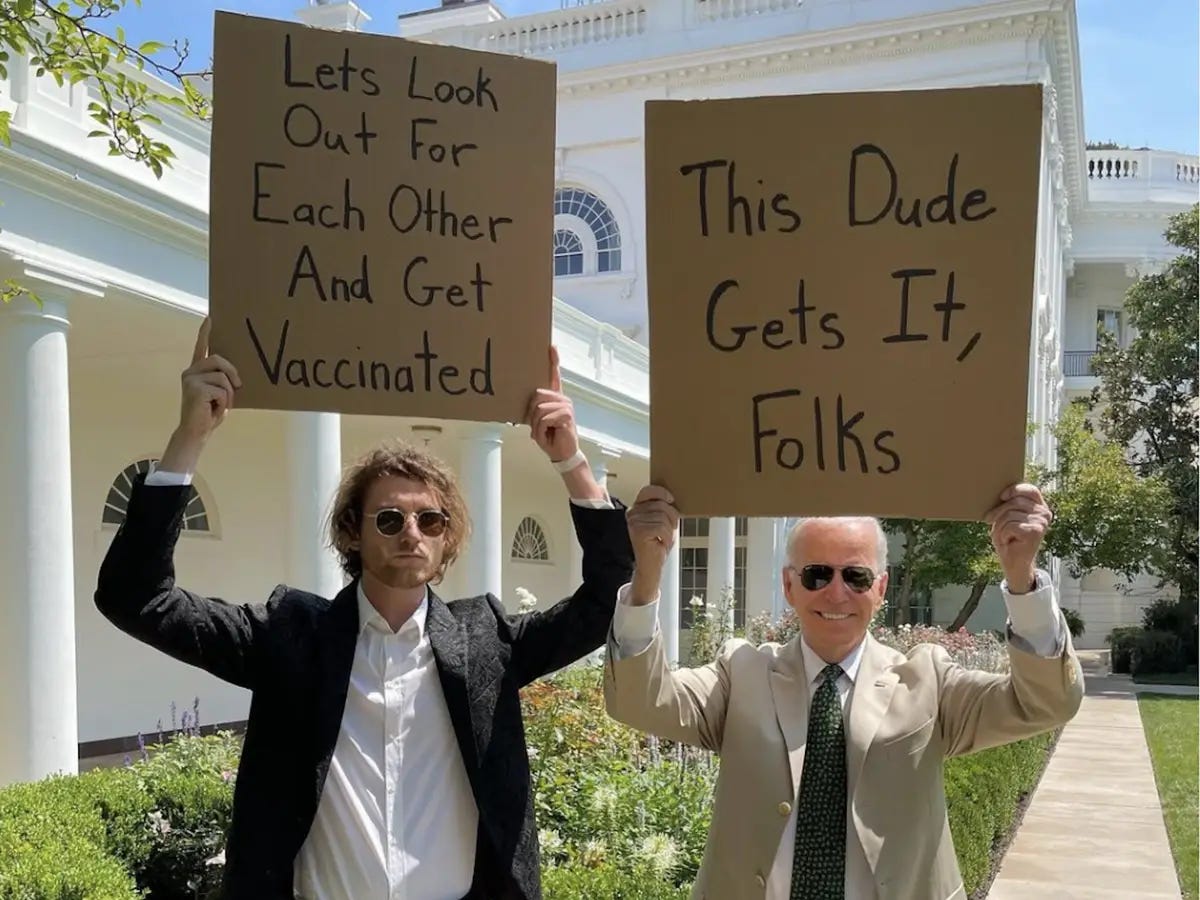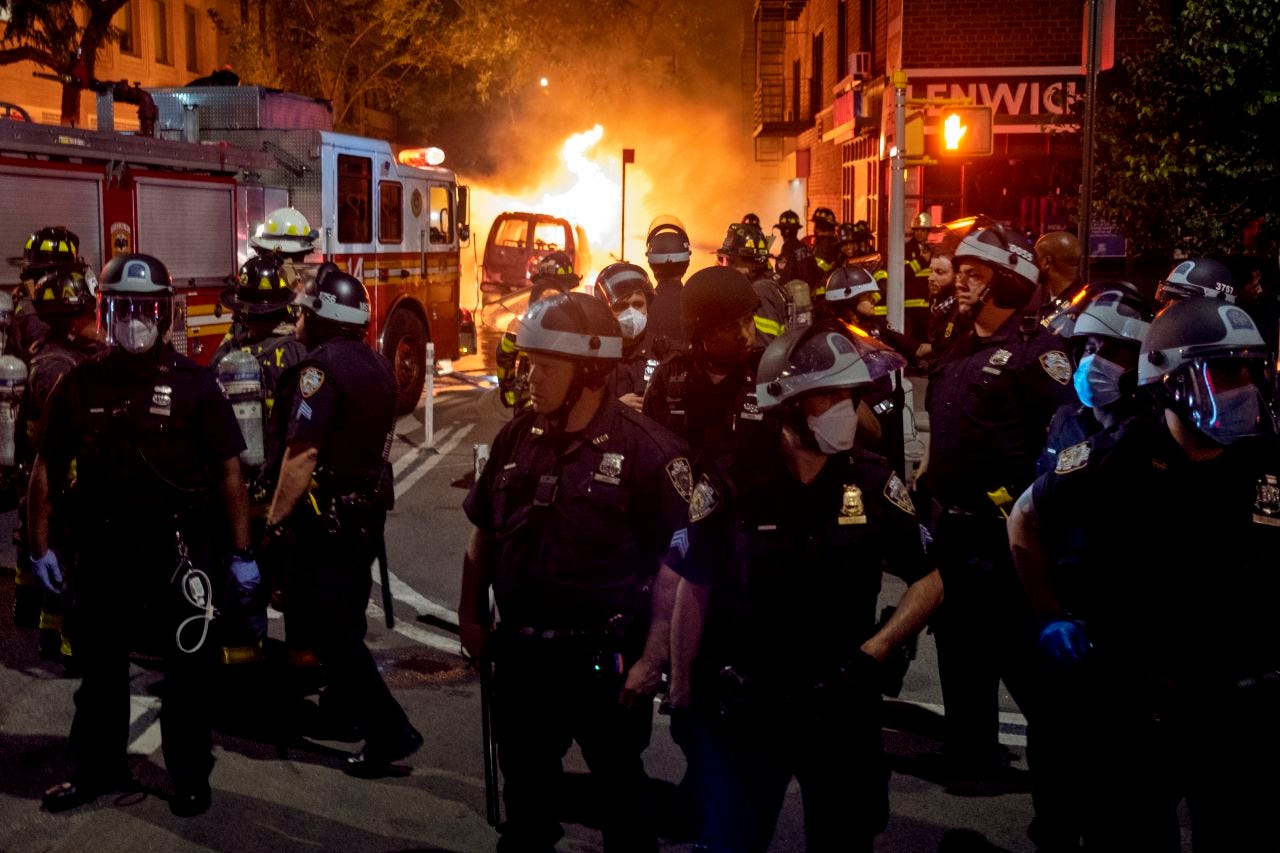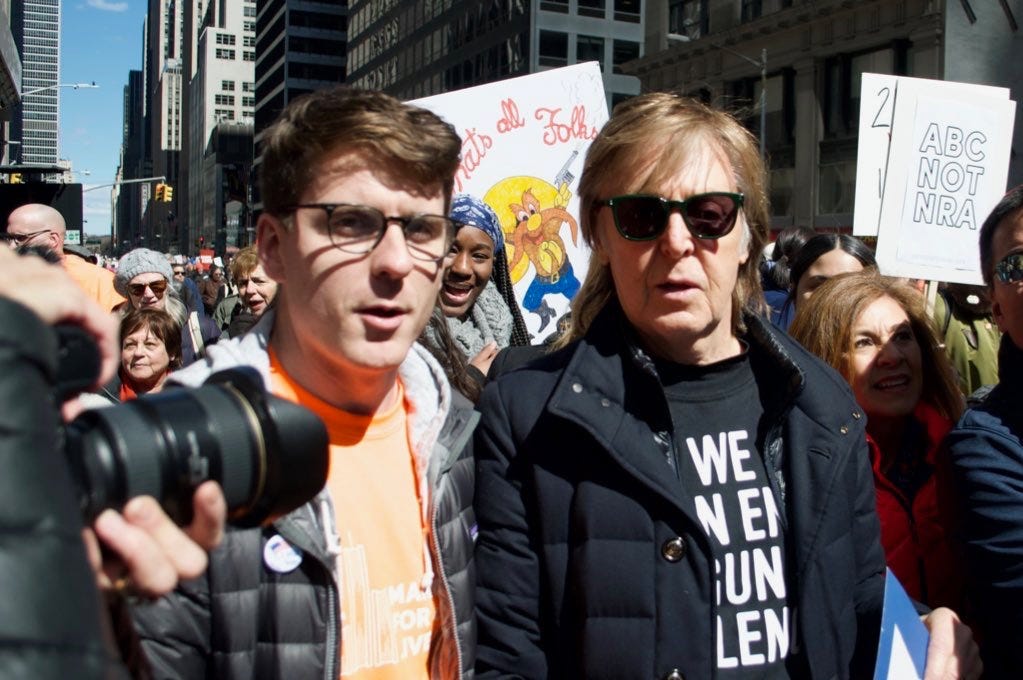How to Protest Without Upsetting Anyone
moral parades & managed rebellion
Self-assured grin on their face, a political influencer well-ingratiated with the Democratic Party holds a sign that reads something akin to “The last guy who tried to do this was TARRED AND FEATHERED.” Not dissimilar from the “dudewithsign” guy, who you may or may not be familiar with, known for holding up cardboard signs that say inane, eye roll-inducing nuggets of wisdom like “Stop Ignoring Your Mental Health.” This is not just what I imagine in my head when I first hear the name of Saturday’s demonstration across the United States, “No Kings;” it is literally what I view on my social media feed.

Something in the ballpark of 2,000 protests and rallies took place across the country: permits were secured, speeches drafted and made ready for sharing across social media, millions marched. The central idea? A rejection of authoritarian rule, of Trump’s surreal military parade and the symbolic violence of military glorification. This overarching event was organized under the banner of the “50501 Movement” – shorthand for “50 protests, 50 states, 1 movement” – a Reddit-born, intentionally leaderless formation with a semi-decent pitch: fuck this, let’s make some noise everywhere, at once.
In some ways, it worked. It felt like something. It looked activated. In New York City, tens of thousands marched. The energy was upbeat, musical even. There was a marching band, clever signs, and someone in a papier-mâché crown with a guillotine cut-out. A dizzying array of zines were handed out. But there was a distinct air of performance about the whole thing, as there has been for the last several years with these types of actions. They are far less “direct action” and more moral parade. They are also more photogenic than disruptive. This isn’t to say it is all bad, but it is important to consider.
New York, despite its history, is no longer the epicenter of direct action. If anything, it’s allergic to it. The city offers a managed, city-sanctioned version of dissent: visible, loud, and largely symbolic. The last time things got seriously hot on the ground in New York City was the same time it was happening all across America, in the summer of 2020, during the protests that followed the brutal murder of George Floyd.

Los Angeles, by contrast, has had recent moments of rupture. Just these past few days, mass protests outside the ICE field office spiraled into confrontations that escalated far beyond what had been planned. Federal agents were deployed. Tear gas was used. People were dragged, zip-tied, hospitalized. The line between demonstration and open rebellion remains porous. There’s an appetite—and many on the ground would say even a need—for confrontation. Call it proximity, call it cultural disposition, but the contrast with the New York protests couldn’t be sharper.
Roughly 13 miles outside Manhattan, in the industrial sprawl of Newark, New Jersey, a small group of fewer than 50 masked protesters gathered not to be seen, but to stop Delaney Hall Detention Center from functioning at full capacity. They didn’t come with signs, but with the intention to disrupt. Federal agents were deployed. There were physical clashes that resulted in arrests and in some cases, physical harm to the protesters. All of them, by nature of being there, put themselves at risk of some form of harm. And yet, it’s possible you didn’t even hear about it.
The “50501 Movement” is internet-seeded, decentralized, and appears, at least on paper, to reject the nonprofit-industrial complex’s suffocating grip on popular protest. That’s good. But as it scaled, it’s drifted into orbit with the usual suspects: large organizations like the ACLU, SEIU, Indivisible. And institutions, by their nature, fear escalation. They fear improvisation. They fear risk. 50501 brands itself, proudly, as a peaceful movement. That’s not a flaw in itself. But the question remains: can a protest movement that explicitly disavows disruption still meaningfully challenge power? Can it grow without being absorbed? Can it move people without merely managing them?
I do believe that something is shifting. I don’t mean in the halls of power; I mean on the street, and in the way people are talking.
When Senator John Fetterman of Israel tweeted a photo of Waymo cars in LA engulfed in flames, he captioned it:
WIN THE ARGUMENT
DO NOT
– loot
– set shit on fire
– assault law enforcement
DO
– protest peacefully
– organize to win elections
– call out destructive behavior like this
It’s the kind of Swiss cheese–brained liberal contradiction that would almost be funny if it weren’t so depressingly common. The image he chose—the literal burning of machines owned by arguably the largest corporate surveillance apparatus—was meant to horrify. But it backfired, because a lot of people saw that and thought: “Yes, good. Burn the Waymos.”
Fetterman, like many in the party apparatus, is fine with spectacle, so long as it’s toothless. He gestures toward radicalism and then shakes his fist disapprovingly at genuine action. People on this tack want to funnel rage into more parades and branding. Feel strongly, they say, but act softly. Never actually interrupt the machinery.
This isn’t new. Capitalism is stunningly effective in its ability to absorb its critiques, digest them, and spit them back out to us as defanged product. “No Kings” becomes a slogan on a tote bag. The performance itself is now consumable.
The response to this critique is always the same: Isn’t it still good to show up? To be loud? To make noise? Yes. But the issue is not whether we feel something. It’s whether it does anything. And I should say, go ahead and go to your protest. Keep doing them! But stop acting like people haven’t been doing it this way, or that we’ve been seeing enough in the way of results.
Yes, of course, the mass events still matter. Not because it’s going to topple anything on its own, but because of what it implies and what it enables. As someone put it online, “The 50 brave souls are the implicit promise of violence if the 50,000 are ignored. The 50,000 are the implicit promise that the 50 could grow to 500 then 5,000 and maybe 5,000,000.” That’s the ecosystem. You don’t get one without the other.
You don’t get a serious campaign of escalating resistance without a base of visible, public support: senior citizens, young parents, tired teachers, quiet believers in change who aren’t going to throw bricks but will show up to swell the ranks. The numbers still matter, but not because they scare the state, necessarily. They matter because they make other people brave.
Here’s something I genuinely don’t understand: why does the suggestion that more is needed piss some people off? Why is it always met with the most ferocious pushback? When I suggested that targeted disruptions were more powerful, one person earnestly replied that they would be immediately murdered if they tried this. This was in response, by the way, to support of the protesters at Delaney Hall Detention Center. None of those protesters have been murdered. What if there had been 400 people there instead of 40? Imagine that: an actual impediment to the functioning of ICE.
During recent anti-ICE protests in Los Angeles, LAPD Chief Jim McDonnell admitted his force was, “overwhelmed” by the remaining protesters. Just a few thousand people led to nearly 400 arrests. Protesters blocked the 101 freeway. In return, 2,000 National Guard troops and 700 Marines were deployed to protect ICE facilities. That’s what actual pressure looks like. Not a march or a speech, but genuine disruption.
The “No Kings” rallies went off largely (one notable exception was again LA, where my friend was nearly hit with a rubber bullet) without incident. Permitted routes, cheerful signs, heavily armed police escorts that were largely unnoticed by the exuberant crowd. In New York, the numbers were large, even considering the terrible weather. But what will be the impact?
I think about the 2018 March for Our Lives rally I helped organize in New York City. 175,000 people marched in the streets. It felt enormous. And it led to... what? A few wins in states that were already leaning left. New faces in safe districts. The core premise—that politicians would rather let kids die than upset the gun lobby—was never really confronted. The entire thing lost steam. It was swallowed up, in part, by the hungry hippo that is the nonprofit-industrial complex. It never became part of a wider movement.
Now look at 2024. The campus uprisings and the Palestinian Youth Movement. People lost their jobs; students lost degrees. It wasn’t aesthetic; it was costly. It didn’t care if it was polite or allowed because it wasn’t trying to get on MSNBC.
That’s the fork in the road: parade or rupture.
There’s a moment from Nelson Mandela’s 1964 speech at the Rivonia Trial that refuses to fade. He and several members of the African National Congress stood accused of sabotage, conspiracy, and attempts to overthrow the apartheid government. They faced the death penalty.
Mandela stood in court, in full knowledge that he might be executed, and said:
“I have cherished the ideal of a democratic and free society in which all persons live together in harmony and with equal opportunities… It is an ideal for which I am prepared to die.”
He said that standing trial for actual direct action. He was naming the cost. He knew what kind of country he lived in and what justice required. No, I don’t think you, or everyone, needs to die or risk their life in order to change America. But clearly, it’s going to take a lot more than what we collectively have been offering.
In America, people are being tortured in solitary confinement. Children are still dying in detention. Families, as we’ve watched over the last several months at an even more aggressive pace, are being torn apart. Every time we gather to chant and march and then go home, we are letting the system believe it can survive us.
When we draw a line between “good” and “bad” protesters, we’re doing the state’s work for it. The state doesn’t care; once it decides you’re in the way or a threat to its power, it will respond with violence.
If we’re serious about “No Kings,” then we have to stop behaving like well-meaning courtiers and start acting like subjects who refuse to kneel.







Another great piece, and I'll be giggling at "Senator John Fetterman of Israel" for the next 3 hours
“Senator John Fetterman of Israel” lmaooooo